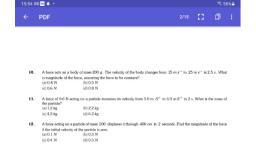Question 1 :
The slope of velocity-time graph for particle moving with uniform velocity is equal to
Question 2 :
Assertion(A): In uniform circular motion the particle has zero acceleration.<br/>Reason (R) : Centripetal force is essential to keep a particle in circular motion.<br/>
Question 3 :
A wheel spins on its axis at a constant rate and hasn't yet made a complete rotation.Which of the following statements is correct?
Question 5 :
The velocity of a body moving with a uniform acceleration of $2 m/sec^2$ is $ 10 m/sec$. Its velocity after an interval of 4 sec is 
Question 6 :
A particle is acted upon by a force of constant magnitude which is always perpendicular to the velocity of the particle. The motion of the particle takes place in the plane. It follows that
Question 9 :
A ball of mass m is thrown straight upward from the top of a multi-storey building with an initial velocity of +15 m/s.<br/>Find out the time taken by the ball to reach its maximum height?<br/>
Question 10 :
A cart is released from rest at the top of a long ramp at time $t = 0$ seconds and moves down the ramp at a constant acceleration rate. At a time of t, the cart has reached a speed of $2 m/s$. How fast will the cart be moving at the time of $3t$?
Question 11 :
A car starts from rest and accelerates uniformly over a time of 5.21 seconds for a distance of 110 m. Determine the acceleration of the car.
Question 12 :
(1) : When a rigid body is rotating about its own axis, all particles of that body have the same angular velocity.<br/> (2) : All particles of the body have the same time period.<br/>
Question 13 :
The motion of a bus going around a traffic roundabout is curvilinear motion. True or false.
Question 14 :
The average acceleration vector for a particle having a uniform circular motion in one complete revolution.
Question 15 :
If the displacement of an object is proportional to square of time, then the object moves with<br/>
Question 16 :
When a body moves in circular path with uniform speed, it's motion is called uniform circular motion<br>State whether given statement is True/False?
Question 17 :
The time taken by a vertically projected body before reaching the ground is:
Question 18 :
Which of the following are examples of uniform circular motion ?
Question 19 :
Consider the following two statements A and B and identify the correct option:<br/>A) When a rigid body is rotating about its own axis at a given instant, all particles of body possess same angular velocity.<br/>B) When a rigid body is rotating about its own axis, the linear velocity of a particle is directly proportional to its perpendicular distance from axis.<br/>
Question 21 :
In uniform circular motion, the velocity vector and acceleration vector are:
Question 22 :
If the body is moving in a circle of radius $r$ with a constant speed $V$, its angular velocity is
Question 23 :
Which of the following quantity remains constant in a uniform circular motion?<br>
Question 24 :
A particles revolves along a circle with a uniform speed. The motion of the particle is ____ .
Question 25 :
Suppose a boy is enjoying a ride on a merry-go-round which is moving with a constant speed of $10\ ms^{-1}$. It implies that the boy is :<br/>
Question 27 :
In uniform circular motion, the factor that remains constant is :
Question 28 :
Circular Motion can be an example of periodic motion. State whether the given statement is True or False.
Question 29 :
Fill in the blank.In circular motion, force is always _______ to the displacement.
Question 30 :
A particle of mass 3 kg moves under the force of $4\hat{i}+8\hat{j}+10\hat{k}$ N. If the particle starts from rest and was at origin initially. Its new co-ordinates after 3 seconds is :
Question 31 :
The total energy of a particle that moves along a circular path in vertical plane is:<br/>
Question 33 :
A car accelerates on a horizontal road due to the force exerted by
Question 34 :
The only property that does not change in a uniform circular motion is
Question 36 :
A body falls freely under gravity from rest and reaches the ground in time $t$. Write expression for the height fallen by the body.
Question 37 :
A particle is acted upon by a force of constant magnitude which is always perpendicular to the velocity of the particle The motion of he particle takes place in a plane It follows that ________
Question 38 :
During the sharpening of a knife with the help of a grind stone, the direction of motion of sparks is:<br/>
Question 39 :
A ball is shot vertically upward with a given initial velocity. It reaches a maximum height of $100$m. If on a second shot, the initial velocity is doubled then the ball will reach a maximum height of.
Question 40 :
A car is moving with speed $2 m/s$ crosses a electric post and starts accelerating at a constant rate of $2m/s^2$. How far past the electric post will the car be after 3 s?
Question 41 :
A truck and a car are moving with equal velocity. On applying brakes, if both decelerate at the same rate,what happens?
Question 43 :
The distance $x$ covered in time $t$ by a body having initial velocity ${ v }_{ 0 }$ and having constant acceleration $a$ is given by $x={ v }_{ 0 }t+1/2a{ t }^{ 2 }$. This result follows from :<br/>
Question 44 :
The distance covered by a body moving along X-axis with initial velocity 'u' and uniform acceleration 'a' is given by $x=ut+\frac {1}{2}at^2$. This result is a consequence of
Question 45 :
If two masses $ m_1,\ m_2$ are thrown vertically upwords with the same velocity, what is the difference in the maximum height gained by them? ($ m_1 > m_2$)<br/>
Question 46 :
A frog that jumps upwards is under the influence of gravity and accelerates at a constant rate.<br>If it has an initial upwards velocity of ${v}_{0}=5.00{m}/{s}$, approximately how far above the ground will it be when it has velocity $v=-2.50{m}/{s}$?
Question 48 :
Which one of the following is most probably not a case of uniform circular motion?
Question 49 :
A stone tied to a string is whirled in a circle. As it is revolving, the string suddenly breaks. The stone then
Question 50 :
A particle moves in a circle describing equal angle in equal times, its velocity vector
Question 51 :
A ball starts rolling on a horizontal surface with an initial velocity of 1 m/s. Due to friction, itsvelocity decreases at the rate of ${0.1 m/s^2}$ , Howmuch time will it take for the ball to stop?
Question 52 :
If a body projected up with a velocity $u$ rises to a height $h$, a body of double the mass projected with a double the velocity rises to a height of:
Question 53 :
A stone is thrown upwards with a velocity $v$ from the top of a tower. It reaches the ground with a velocity $3v$. What is the height of the tower?<br/>
Question 54 :
A body at rest starts sliding from top of a smooth inclined plane and requires $4 s$ to reach bottom. How much time does it take, starting from rest at top, to cover one-fourth of a distance?
Question 55 :
Which of the following graphs should be used to represent the percentage of boys and girls in a class?
Question 56 :
A train 50 m long passes over a bridge at a constant velocity of 30 km/h. If it takes 36 s to cross the bridge, the length of the bridge will be
Question 57 :
The free end of a thread wound on a bobbin is passed round a nail $A$ hammered into the wall. The thread is pulled at a constant velocity. Assuming pure rolling of bobbin, find the velocity $v_0$ of a center of theybobbin at heh center at he instant when the thread forms an angle $\alpha$ with the vertical.
Question 58 :
What will the ball's speed be when it returns to its starting point? (in m/s)
Question 59 :
A pebble is dropped freely in a well from its top. It takes $20\ s$ for the pebble to reach the water surface in the well. Taking $g=10\ ms^{-2}$ and speed of sound $=330\ ms^{-1}$, find: (i) the depth of water surface from the top, and (ii) the time when echo is heard after the pebble is dropped?
Question 60 :
A body is projected vertically upward with an initial velocity $u$. If acceleration due to gravity is $g$, the time for which it remains in air, is
Question 61 :
A particle moves along the x-axis with a position given by the equation $x = 5 + 3t$, where $x$ is in meters, and $t$ is in seconds. The positive direction is east. Which of the following statements about the particle is false?<br/>
Question 62 :
The slope of the velocity time graph for retarded motion is
Question 63 :
A particle moves along x-axis in such a way its coordinate (x) varies with time (t) according to the expression $x=2-5t+6t^2$. its intial velocity is<br>
Question 64 :
A body projected vertically upwards with a velocity of $19.6\; ms^{-1}$ reaches a height of$19.6\; m$on earth. If it is projected vertically up with the same velocity on moon, then the maximum height reached by it is ($g_{earth}=g \ ms^{-2}$, $g_{moon}=\dfrac{g}{6}\ ms^{-2}$)
Question 65 :
A particle is moving along a circular path with a constant speed $30\,m/s$. What is change in velocity of particle, when it decreases an angle of ${90^ \circ }$ at the center of the circle ?
Question 66 :
A stone is dropped from a rising balloon at a height of 300 m above the ground and it reaches the ground in 10 s. The velocity of the balloon when it was dropped is :<br/>
Question 67 :
If a car at rest accelerates uniformly and attains a speed of 72 km/hr in 10 s, then it covers a distance of:
Question 68 :
A car, starting from rest, accelerates at the rate $f$ through a distance $S$, then continues at constant speed for time $t$ and then decelerates at the rate $\frac{f}{2}$ to come to rest. If the total distance traversed is $15S$, then
Question 69 :
A particle of mass m is tied to a string of length L. The free end of the string is fixed and the particle is whirled in a circular path. The speed of the particle increases from 5 m/s to 10 m/s for 5 secs. The motion is
Question 70 :
From street level, Superman spots Lois Lane in trouble. The evil villain, Lex Lutheor is dropping her from near the top of the Empire State Building. At the very instant, the man of steel starts upward at a constant acceleration to attempt a mid-air rescue of Lois. Assuming she was dropped from a height of $300\ m$ and the Superman can accelerate straight upward at $15\ m/s^2$. Determine how far Lois falls before he catches her.
Question 71 :
Uniform linear motion is a/an _______ motion while uniform circular motion is a/an _______ motion. 
Question 73 :
A small ball rolls of the top of a stairway horizontally with a velocity of $4.5 ms^{-1}$. Each step is $0.2 m$ high and $0.3$ m wide. If g is $10$ ms$^{-2}$, then the ball will strike the $n^{th}$ step where $n$ is equal to (assume ball strike at the edge of the step)































